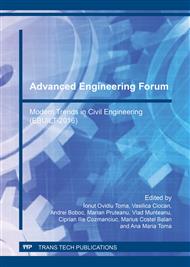[1]
Okamura H., Outchi M., Self-Compacting Concrete, Journal of Advanced technology 1, (2003), 5-15.
Google Scholar
[2]
Kumar D. S., Rajeev C., Development of Self Compacting Concrete by use of Portland Pozzolana Cement, Hydrated Lime and Silica Fume, ISCA Journal of Engineering Sciences, 1, (2012), 35-39.
Google Scholar
[3]
EFNARC, EFCA, Guidelines for Viscosity Modifying Admixtures for Concrete, (2006).
Google Scholar
[4]
Reza S. A., Tahir K. E., Kambiz R., Effect of various supplementary cementitious materials on rheological properties of self-consolidating concrete, Construction and Building Materials, (2015), 89-98.
DOI: 10.1016/j.conbuildmat.2014.11.014
Google Scholar
[5]
Mohammed M.K., Dawson A.R., Thoma N.H., Production, microstructure and hydration of sustainable self-compacting concrete with different types of filler, Construction and Building Materials, Nr. 49, (2013), 84–92.
DOI: 10.1016/j.conbuildmat.2013.07.107
Google Scholar
[6]
Metha K.P., Monteiro P. J, M, Concrete microstructure, properties and materials, California: The McGraw-Hill Companies, (2006).
Google Scholar
[7]
Dinakar P., Babu K.G., Santhanam M, Durability properties of high volume fly ash self compacting concretes, Cement & Concrete Composites, (2008) p.880–886.
DOI: 10.1016/j.cemconcomp.2008.06.011
Google Scholar
[8]
Saurabh K. S., Vijay P. S., Ranjeet K., Sena A.K., A review on effect of mineral admixture on self compacting concrete, International Journal of Civil Engineering, Vol. 3, (2014), 79-90.
Google Scholar
[9]
Ponikiewski T., Go1aszewski J, The influence of high-calcium fly ash on the properties of fresh and hardened self-compacting concrete and high performance selfcompacting concrete, Journal of Cleaner Production, Nr. 72, (2014), 212-221.
DOI: 10.1016/j.jclepro.2014.02.058
Google Scholar
[10]
Dinakar P., Sethy K.P., Sahoo U.C., Design of self-compacting concrete with ground granulated blast furnace slag, Materials and Design, Nr. 43, (2013) p.161–169.
DOI: 10.1016/j.matdes.2012.06.049
Google Scholar
[11]
Tutikian B. F., Pacheco M., Self-compacting concrete (SSC) - comparison of methods of dosage, Ibracon Structures and Materials Journal Vol5., nr. 4, (2012), 500-529.
DOI: 10.1590/s1983-41952012000400006
Google Scholar
[12]
Alqadi A., Nasharuddin K., Naganathan C., Development of self-compacting concrete using contrast constant factorial design, Journal of King Saud University – Engineering Sciences, (2013), 105–112.
DOI: 10.1016/j.jksues.2012.06.002
Google Scholar
[13]
BIBM, CEMBUREAU, ERMCO, EFCA, EFNARC., The European Guidelines for Self-Compacting Concrete. Specification, Production and Use, (2005).
Google Scholar
[14]
D. Rich, On-site application of self-compacting concrete (SCC). Doctoral Thesis, Loughborough: School of Civil & Building Engineering, Loughborough University, (2014).
Google Scholar
[15]
Eurostat, Labour costs in the EU, (2015).
Google Scholar
[16]
Feys D., De Schutter G., Verhoeven R., Parameters influencing pressure during pumping of self-compacting concrete, Materials and Structures, vol. 46, (2013) p.533–555.
DOI: 10.1617/s11527-012-9912-4
Google Scholar
[17]
ERMCO (European Ready Mixed Concrete Organization), Guidance to the engineering properties of concrete, (2006).
Google Scholar
[18]
Khayat K.H., Bonen D., Shah S., Taylor P., SCC formwork pressure, The national ready-mix concrete research foundation, (2007).
Google Scholar
[19]
Goodier C., Development of self-compacting concrete, Structures & Buildings, 156, (2003), 405–414.
Google Scholar
[20]
Malherbe J., Self-compacting concrete versus normal compacting concrete: A techno-economic analysis, Cape town: Stellenbosch University, South Africa, (2015).
Google Scholar


